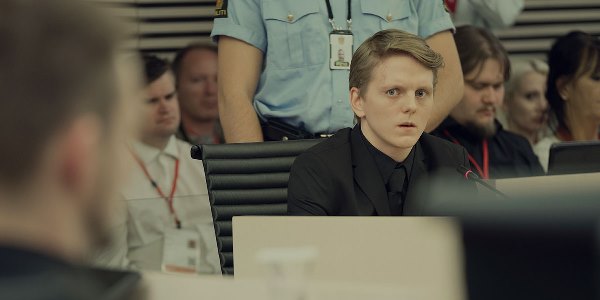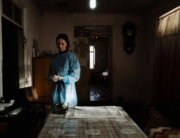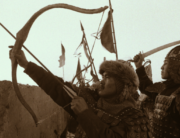![]() The film I most dreaded seeing at the Toronto International Film Festival turned out to be the most riveting I saw there. The hesitation was partially due to the subject matter, the real-life killings of 77 people on July 22, 2011, by a right-wing terrorist. I had also already sat through what seemed to be an all-misery pass at the festival, having witnessed the 1820 massacre of peaceful English protesters reenacted in Mike Leigh’s Peterloo, three killings of unarmed men of color by cops (such as in The Hate U Give), and the surreal tour of war-torn Syria in The Day I Lost My Shadow. However, Paul Greengrass’s new film is gripping from start to finish, and despite its dire subject matter, it ultimately conveys a positive outlook.
The film I most dreaded seeing at the Toronto International Film Festival turned out to be the most riveting I saw there. The hesitation was partially due to the subject matter, the real-life killings of 77 people on July 22, 2011, by a right-wing terrorist. I had also already sat through what seemed to be an all-misery pass at the festival, having witnessed the 1820 massacre of peaceful English protesters reenacted in Mike Leigh’s Peterloo, three killings of unarmed men of color by cops (such as in The Hate U Give), and the surreal tour of war-torn Syria in The Day I Lost My Shadow. However, Paul Greengrass’s new film is gripping from start to finish, and despite its dire subject matter, it ultimately conveys a positive outlook.
An English-language production with a Norwegian cast, the film drops viewers into the day before the massacre as Greengrass intercuts between Anders Behring Breivik (Anders Danielsen Lie) manufacturing a bomb and the arrival of teenagers at the Labour Party Youth Camp on Utoya Island, 40 kilometers from Oslo. On the following day, Breivik sets off a car bomb near government buildings in the capital and drives to Utoya Island, gaining entry to the camp by posing as a police officer, there to secure the island.
Whether one is thoroughly familiar with the attacks or not, the rampage on the island is depicted as terrifying and brutal as Breivik strides across the campground and robotically fires his automatic weapon at the fleeing victims, most of whom are teens. The reenactment of this atrocity takes place within the first 30 minutes, but the filmmakers’ main focus centers on the aftermath and reverberations of the attack, both for the country and one specific teenager, Viljar (Jonas Strand Gravli, in a remarkable performance), who was shot multiple times. Along with losing an eye, he is unable to walk unaided, and one of the bullets exploded in his head, embedding fragments into his brain stem. If they shift, it could be fatal.
After his arrest, 32-year-old Breivik handpicks his defense attorney, Geir Lippestad (Jon Oigarden), because of the latter’s previous work defending neo-Nazis in a murder case. In many ways, he is not an obvious choice. The real-life chairman of a left-wing think tank, Agenda, and a member of the Norwegian Labour Party, Lippestad has spoken out against discrimination. By contrast, in their first meeting, Breivik is upfront about his intentions to end multiculturalism in Europe—on his home computer, police find his manifesto entitled “A European Declaration of Independence.” He will also later say he wanted to hit the victims’ parents, members of the ruling Labour Party, where it would hurt them the most.
The by-the-book Lippestad is presented as a family man who stoically believes that everyone is entitled to legal representation. First, he has to consider what line of defense to pursue. He and his team decide Breivik should plead insanity so he can be sentenced to a hospital for treatment, and psychiatrists for the defense diagnose him as paranoid schizophrenic. Yet leading up to the trial, Breivik changes his plea to guilty; he wants to be heard. The court eventually allows him to speak in his defense, raising fears from the victims’ families that he will turn the trial into a propagandic platform.
Months after the attacks, Viljar is released from hospital, and he and his family drive 2,500 kilometers north back to their small, snow-covered town of Svalbard, surrounded by mountains, where his mom is the mayor. (This airy change of scenery, which may not be appear as majestic on the small screen as it does in theaters, dispels any sense of claustrophobia from the interrogation room and hospital scenes, and it serves as a welcome respite before the courtroom section.) If Viljar is experiencing the seven stages of grief, he is then trapped in the anger phase, based on his behavior. In a film featuring one alarming moment after another, one of the most harrowing, which occurs on an isolated snowy field, is an act that is either reckless or deliberately lethal on his part.
It could be easily argued that the main characters here are not, in fact, the threatened moral values of Norway but the terrorist. Although the screenplay allows Breivik to explain himself, it never justifies his ideas or actions, and as such he does not hijack the film. The decision to portray him as a central figure in the docudrama is the filmmakers’ most controversial and divisive choice. However, the actions of others and the visceral depiction of the violence that Breivik wrought undercut his sanctimonious pontifications and rants against Muslims.
By depicting Breivik, the film addresses the underlying issue of the spread of right-wing, xenophobic nationalism, as possibly a precursor to the politics of anger that would rise in many countries just a few years later. However, the few moments when the script veers toward becoming didactic occur when Lippestad, presumably speaking for the filmmakers, makes it clear to Breivik that he does not support his client’s agenda; he also refuses to shake his hand at the end of the trial.
Greengrass’s narrative culminates in Breivik’s trial in Oslo District Court, located only blocks from where the rampage started, and climaxes with Viljar on the witness stand. As improbable as this may sound, the film is an indirect, modern-day descendant of Frank Capra’s films, where optimism or hopefulness win the day. The teenager’s testimony has none of the anger or retribution of Breivik’s vitriol. On the contrary, his response to the violence and incomprehensible thinking behind it is soft-spoken and gentle. The film, in its own way, offers an answer to these types of horrific events. However, it’s also a wakeup call, as the last words Breivik says are, “We will beat you. You can’t even see us.”
This film was one of a half-dozen premieres in Toronto that will be distributed by Netflix, and unlike many movies that will be presented by the streaming giant, 22 July will have no problem grabbing the attention of viewers. It’s fast-paced, intimate, and the subject matter is intrinsically riveting, no matter where it is streamed.
22 July will begin streaming on Netflix on October 10.







Leave A Comment